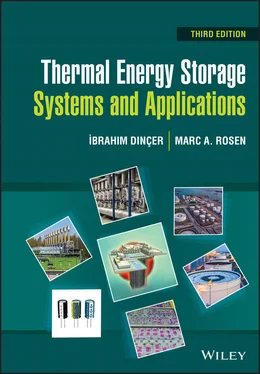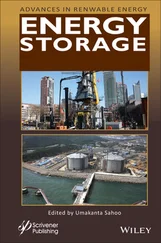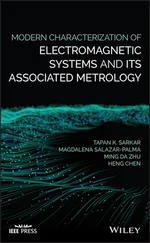Ibrahim Dincer - Thermal Energy Storage Systems and Applications
Здесь есть возможность читать онлайн «Ibrahim Dincer - Thermal Energy Storage Systems and Applications» — ознакомительный отрывок электронной книги совершенно бесплатно, а после прочтения отрывка купить полную версию. В некоторых случаях можно слушать аудио, скачать через торрент в формате fb2 и присутствует краткое содержание. Жанр: unrecognised, на английском языке. Описание произведения, (предисловие) а так же отзывы посетителей доступны на портале библиотеки ЛибКат.
- Название:Thermal Energy Storage Systems and Applications
- Автор:
- Жанр:
- Год:неизвестен
- ISBN:нет данных
- Рейтинг книги:4 / 5. Голосов: 1
-
Избранное:Добавить в избранное
- Отзывы:
-
Ваша оценка:
- 80
- 1
- 2
- 3
- 4
- 5
Thermal Energy Storage Systems and Applications: краткое содержание, описание и аннотация
Предлагаем к чтению аннотацию, описание, краткое содержание или предисловие (зависит от того, что написал сам автор книги «Thermal Energy Storage Systems and Applications»). Если вы не нашли необходимую информацию о книге — напишите в комментариях, мы постараемся отыскать её.
Provides students and engineers with up-to-date information on methods, models, and approaches in thermal energy storage systems and their applications in thermal management and elsewhere Thermal Energy Storage: Systems and Applications
Thermal Energy Storage: Systems and Applications, Third Edition
Thermal Energy Storage Systems and Applications — читать онлайн ознакомительный отрывок
Ниже представлен текст книги, разбитый по страницам. Система сохранения места последней прочитанной страницы, позволяет с удобством читать онлайн бесплатно книгу «Thermal Energy Storage Systems and Applications», без необходимости каждый раз заново искать на чём Вы остановились. Поставьте закладку, и сможете в любой момент перейти на страницу, на которой закончили чтение.
Интервал:
Закладка:
Greek Letters
Φtemperature difference, °C or Kθangleβvolumetric coefficient of thermal expansion, 1/Kδincrement; differenceμdynamic viscosity, kg/ms; root of the characteristic equationρdensity, kg/m3νkinematic viscosity, m2/s∆thickness of the stagnant film of fluid on the surface, m∆Ttemperature difference, K; overall temperature difference, °C or KσStefan–Boltzmann constant, W/m2 K4; electrical conductivity, 1/ohmεsurface emissivity, eddy viscosityτshear stress, N/m2∑summationπnumber (=3.14159)
Subscripts and Superscripts
aair; medium; surroundingsavaverageAfluid AbblackBfluid Bcconvection, criticalcdconductioncscontrol surfacecvcontrol volumeDdiametereelectrical; end; exitffluid; final; flow; force; frictionfmfilm conditionhheat generationHhigh temperaturehsheat storageicomponent; inputieinternal energylliquidLlow temperatureliqliquidmmidplane for plane wall; centerline for cylindermixmixturennth valuenbnonblackppreviousrradiationssurface; near surface; saturation; free stream; in direction parallel to streamlinettotal; thermaltottotalxx‐directionvvaporvapvaporyy‐directionzz‐directionsurroundings; ambient; environment; reference1first value; first state; initial1, 2, 3points
References
1 1 Raznjevic, K. (1995). Handbook of Thermodynamic Tables, 2nd edition. New York: Begell House.
2 2 Dincer, I. (2020). Thermodynamics: A Smart Approach. New York: Wiley.
3 3 Moran, M.J. and Shapiro, H.N. (2007). Fundamentals of Engineering Thermodynamics, 6e. New York: Wiley.
4 4 Szargut, J., Morris, D.R., and Steward, F.R. (1988). Exergy Analysis of Thermal, Chemical, and Metallurgical Processes. New York: Hemisphere.
5 5 Dincer, I. (1997). Heat Transfer in Food Cooling Applications. Washington, DC: Taylor & Francis.
6 6 Dincer, I. and Rosen, M.A. (2013). Energy: Energy, Environment and Sustainable Development. 2nd edition. New York: Elsevier.
7 7 Dincer, I. (1998). Thermodynamics, exergy and environmental impact. Proceedings of the ISTP‐11, the 11th International Symposium on Transport Phenomena.
8 8 Olson, R.M. and Wright, S.J. (1991). Essentials of Engineering Fluid Mechanics. New York: Harper & Row.
9 9 Dincer, I. and Rosen, M.A. (1999). Energy, environment and sustainable development. Applied Energy 64: 427–440.
Study Questions/Problems
Introduction, Thermodynamic Properties
1 1.1 Why are SI units most widely used throughout the world?
2 1.2 What is the difference between mass and weight?
3 1.3 What is specific heat? Define two commonly used specific heats. Is specific heat a function of temperature?
4 1.4 Explain the operating principle of thermocouples. List some typical applications for different types of thermocouples. What is the main advantage of thermocouples over other temperature sensors?
5 1.5 Consider the flow of a refrigerant vapor through a compressor, which is operating at steady‐state conditions. Do mass flow rate and volume flow rate of the refrigerant across the compressor remain constant?
6 1.6 Consider a refrigeration system consisting of a compressor, an evaporator, a condenser, and an expansion valve. Is it best to evaluate each component as a closed system or as a control volume, and as a steady‐flow system or unsteady‐flow system? Explain.
7 1.7 What is the difference between an adiabatic system and an isolated system?
8 1.8 Define intensive and extensive properties. Identify the following properties as intensive or extensive: mass, volume, density, specific volume, energy, specific enthalpy, total entropy, temperature, pressure.
9 1.9 Define the terms system, process, and cycle.
10 1.10 What is the difference between gauge pressure, absolute pressure, and vacuum? Define atmospheric pressure.
11 1.11 What is the difference between mass flow rate and volumetric flow rate? How are these related?
12 1.12 Define the critical point and explain the difference between critical point and triple point.
13 1.13 Define sensible and latent heats, and latent heat of fusion. What are their units?
14 1.14 What is the weight of a 10 kg substance in N, kN, kgf, and lbf?
15 1.15 The vacuum pressure of a tank is given to be 40 kPa. If the atmospheric pressure is 95 kPa, what is the gauge pressure and absolute pressure in kPa, kN/m2, lbf/in2, psi, and mmHg.
16 1.16 Express the temperature −40°C in units of Fahrenheit (°F), Kelvin (K), and Rankine (R).
17 1.17 The temperature of air changes by 10°C during a process. Express this temperature change in Kelvin (K), Fahrenheit (°F), and Rankine (R) units.
18 1.18 The specific heat of water at 25°C is given to be 4.18 kJ/kg°C. Express this value in kJ/kg K, J/g°C, kcal/kg°C, and Btu/lbm°F.
19 1.19 A 0.2 kg mass of R134a at 700 kPa pressure and at 4°C is heated until 50% of mass is vaporized. Determine the temperature at which the refrigerant is vaporized, and the sensible heat and the latent heat are transferred to the refrigerant.
20 1.20 A 0.5 lbm mass of R134a at 100 psa pressure and 40°F is heated until 50% of mass is vaporized. Determine the temperature at which the refrigerant is vaporized, and the sensible heat and the latent heat are transferred to the refrigerant.
21 1.21 A 2 kg mass of ice initially at −18°C is heated until 75% of the mass is melted. Determine the sensible heat and the latent heat transferred to the water. The specific heat of ice at 0°C is 2.11 kJ/kg°C, and the latent heat of fusion of water at 0°C is 334.9 kJ/kg.
22 1.22 A 2 kg mass of ice initially at −18°C is heated until it becomes liquid water at 20°C. Determine the sensible heat and the latent heat transferred to the water. The specific heat of ice at 0°C is 2.11 kJ/kg°C, and the latent heat of fusion of water at 0°C is 334.9 kJ/kg.
23 1.23 Refrigerant 134a enters the evaporator of a refrigeration system at −24°C with a quality of 25% at a rate of 0.22 kg/s. If the refrigerant leaves the evaporator as a saturated vapor, determine the rate of heat transfer to the refrigerant. If the refrigerant is heated by water in the evaporator, which experiences a temperature rise of 16°C, determine the mass flow rate of water.
Ideal Gases and the First Law of Thermodynamics
1 1.24 What is the compressibility factor?
2 1.25 When can we invoke the ideal gas assumption for real gases?
3 1.26 Define isothermal, isobaric, and isochoric processes.
4 1.27 What is an isentropic process? Is a constant‐entropy process necessarily reversible and adiabatic?
5 1.28 What is the difference between heat and work?
6 1.29 An elastic tank contains 0.8 kmol of air at 23°C and 600 kPa. Determine the volume of the tank. If the volume is doubled at the same pressure, what is the temperature at the new state?
7 1.30 A 50 l piston–cylinder device contains oxygen at 52°C and 170 kPa. If the oxygen is heated until its temperature reaches 77°C, what is the amount of heat transfer during the process?
8 1.31 A 50 l rigid tank contains oxygen at 52°C and 170 kPa. If the oxygen is heated until its temperature reaches 77°C, what is the amount of heat transfer during the process?
9 1.32 A 50 l rigid tank contains oxygen at 52°C and 170 kPa. If the oxygen is heated until the temperature reaches 77°C, what is the entropy change during the process?
10 1.33 A rigid tank contains 2.5 kg of oxygen at 52°C and 170 kPa. If the oxygen is heated in an isentropic process until it reaches 77°C, what is the pressure at the final state? What is the work interaction during this process?
11 1.34 A piston–cylinder device contains 2.5 kg oxygen at 52°C and 170 kPa. If the oxygen is heated until it reaches 77°C, what is the work done and the amount of heat transfer during the process?
Читать дальшеИнтервал:
Закладка:
Похожие книги на «Thermal Energy Storage Systems and Applications»
Представляем Вашему вниманию похожие книги на «Thermal Energy Storage Systems and Applications» списком для выбора. Мы отобрали схожую по названию и смыслу литературу в надежде предоставить читателям больше вариантов отыскать новые, интересные, ещё непрочитанные произведения.
Обсуждение, отзывы о книге «Thermal Energy Storage Systems and Applications» и просто собственные мнения читателей. Оставьте ваши комментарии, напишите, что Вы думаете о произведении, его смысле или главных героях. Укажите что конкретно понравилось, а что нет, и почему Вы так считаете.












